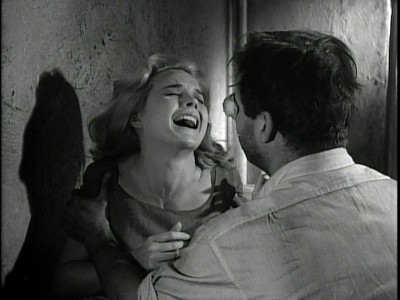Directed by Jack Garfein
Written by Jack Garfein and Alex Karmel
USA, 1961
For an era as socially untactful as the 1960’s, Jack Garfein’s Something Wild, a story about a young rape victim struggling with the aftermath of her attack, must’ve been nothing short of avant-garde. As daring and inventive as it might’ve been, the film’s fractured tone, contrived melodramatic conflict and anachronistically iniquitous conclusion have made it an exhausting, glib, and outdated look at sexual assault.
In New York, Mary Ann Robinson (Carroll Baker) is raped while on her way home from work. As a result, she lives her life in extreme anguish. Alone, misunderstood, and marginalized, she is eventually pushed to the brink, but when a seemingly good Samaritan saves her, Mary finds herself at the mercy of his dubious intentions.
 The first 15 minutes of the film, which contains no dialogue and a nominal score, serves as a synecdoche for its technical achievements. Haunting with its natural and minimalistic approach, Something Wild does not try to manipulate; rather, it saturates the film with a cascade of imagery, provoking the viewer to delve into the character’s anima with tacit regard (this becomes somewhat problematic with the film’s incongruously overbearing score).
The first 15 minutes of the film, which contains no dialogue and a nominal score, serves as a synecdoche for its technical achievements. Haunting with its natural and minimalistic approach, Something Wild does not try to manipulate; rather, it saturates the film with a cascade of imagery, provoking the viewer to delve into the character’s anima with tacit regard (this becomes somewhat problematic with the film’s incongruously overbearing score).
From her overuse of water to the plethora of images involving homeless people, Garfein lets the viewer commiserate with Mary by allowing us to decrypt the film’s abundance of imagery, and thanks to Eugen Schüfftan’s reliably astute cinematography, the images have a certain melancholy beauty.
 Furthermore, an not unlike Polanski’s Rosemary’s Baby, New York itself becomes a fixture in the storytelling, representing urban alienation and the widespread distrust of strangers.
Furthermore, an not unlike Polanski’s Rosemary’s Baby, New York itself becomes a fixture in the storytelling, representing urban alienation and the widespread distrust of strangers.
As the tortured Mary, Carroll Baker puts in an uncompromising performance, one that both commands and demands the viewer’s attention. The film works best when it’s firmly fixated on her, and because of her unquestionable gravitas, she is able to hypnotically exude unspoken feelings of discontent.

But when we are introduced to Mike, the man who literally and figuratively saves Mary from her straitened circumstances, the pacing becomes interminable due to the facile and unconscionable oversimplification of Mary’s sexual assault.
 The lengthy and flippant apartment sequence, which was to infamously become the film’s magnum opus, is patently devoid of the credibility that it had in the first half, making the entire exercise trite and tiresome. If the exposition consists of understanding the ramifications of rape, the conflict comes from the attempt to understand the psyche of the rapist and clashing it with the exposition.
The lengthy and flippant apartment sequence, which was to infamously become the film’s magnum opus, is patently devoid of the credibility that it had in the first half, making the entire exercise trite and tiresome. If the exposition consists of understanding the ramifications of rape, the conflict comes from the attempt to understand the psyche of the rapist and clashing it with the exposition.
The excuses they come up with are jarringly superficial, especially compared to the detailed and nuanced examination of Mary’s experiences. The reasoning itself does not justify any sympathy, and it doesn’t convincingly explain the capricious nature of the rapist. The film, however, believes that it does, and the fact that it acts as if the antagonism is ostensibly resolved is appalling.
 Even worse is the film’s ending; a grossly unfair conclusion that will surely infuriate anyone with the slightest sense of modern sensibility. For those who don’t want it spoiled, the film culminates with the relinquishing of responsibility and the subjugation of justice.
Even worse is the film’s ending; a grossly unfair conclusion that will surely infuriate anyone with the slightest sense of modern sensibility. For those who don’t want it spoiled, the film culminates with the relinquishing of responsibility and the subjugation of justice.
(**SPOILER** For those that don’t mind, the ending is a sickening case of extreme Stockholm Syndrome **SPOILER**)
Although Something Wild starts off as a heroic feminist portrayal of rape, it eventually devolves into a sorry case of misogynistic apologetics.
-Justin Li
Visit the official website for the TJFF



